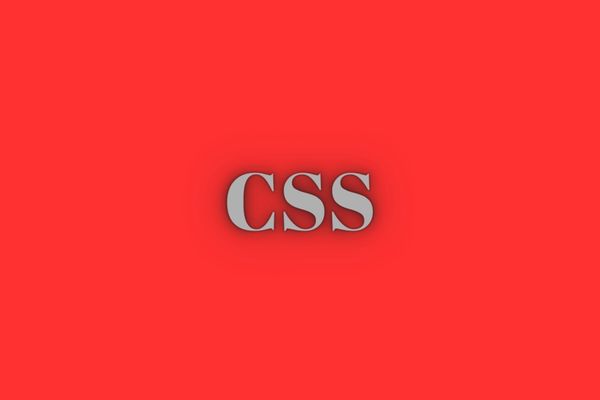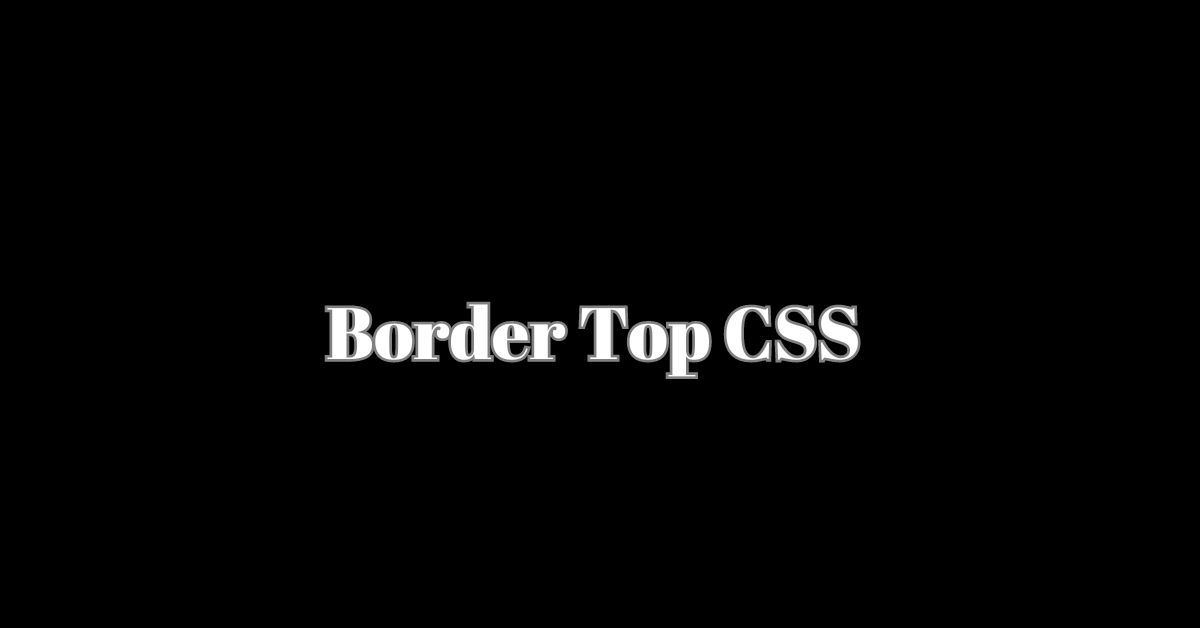CSS, or Cascading Style Sheets, is a fundamental technology in web design. It allows you to control the layout and presentation of your web pages. One important aspect of CSS is the border property, and in this comprehensive guide, we’ll delve into the specific topic of “Border-Top via CSS.” By the end of this article, you’ll have a thorough understanding of how to use and style border tops to enhance the appearance of your web content.
The Basics of CSS Borders
Before we dive into Border-Top using CSS, let’s recap the basics of CSS borders. Borders are used to create boundaries around HTML elements. They can be applied to various sides of an element, including top, bottom, left, and right. Borders have three main attributes: style, width, and color.
Understanding the Border-Top Property
The “border-top” property in CSS specifically deals with the top border of an element. It allows you to control the style, width, and color of the top border independently from the other sides.
Here’s an example of using the “border-top” property in CSS:
/* CSS */
div {
border-top: 2px solid #007bff;
}In this example, we apply a 2-pixel wide solid blue border to the top of a div element.
How to Set the Border-Top Style
In this section, we’ll explore different border-top styles that you can apply to your HTML elements, including solid, dashed, dotted, and double borders.
For instance, to create a dashed top border, you can use the following code:
/* CSS */
div {
border-top: 2px dashed #ff5722;
}This code results in a 2-pixel wide dashed border in orange on the top of a div element.
Setting Border-Top Width
Controlling the width of the border top is essential for achieving the desired visual effect. We’ll discuss how to adjust the thickness of your top border.
/* CSS */
div {
border-top: 4px solid #4caf50;
}In this code, we set a 4-pixel wide solid green border at the top of a div element.
Choosing Border-Top Color
Learn how to pick the perfect color for your top border, whether it’s a solid color or a gradient.
/* CSS */
div {
border-top: 3px solid #f44336;
}This code creates a 3-pixel wide solid red border at the top of a div element.
Using Shorthand Border-Top Property
CSS provides shorthand properties to simplify your code. Discover how to use shorthand for setting border-top properties more efficiently.
For example, you can set all border-top properties using shorthand like this:
/* CSS */
div {
border-top: 2px dotted #673ab7;
}This code combines width, style, and color in one line, resulting in a 2-pixel wide dotted border in deep purple at the top of a div element.
Adding Border-Top with Gradient
Create eye-catching top borders by incorporating gradients. We’ll guide you through the process of using gradient colors for your top borders.
/* CSS */
div {
border-top: 2px linear-gradient(to right, #2196f3, #4caf50);
}This code applies a 2-pixel wide gradient border from blue to green at the top of a div element.
Creating Dashed and Dotted Border-Top
Dashed and dotted border-top styles can add a unique touch to your design. We’ll show you how to achieve these effects.
/* CSS */
div {
border-top: 2px dashed #ff9800;
}In this code, a 2-pixel wide dashed orange border is applied at the top of a div element.
Customizing Border-Top with Images
Images can be used to customize your top borders. Learn how to incorporate images into your border-top styling.
/* CSS */
div {
border-top: 4px solid transparent;
border-image: url('border-image.png') 30 round;
}This code sets a 4-pixel wide solid border at the top of a div element and uses an image named ‘border-image.png’ to create a decorative border.
Responsive Border-Top Styles
Adapting your top border styles for different screen sizes is crucial for a responsive design. We’ll explore techniques to make your border-tops responsive.
/* CSS */
@media (max-width: 768px) {
div {
border-top: 2px solid #9c27b0;
}
}
@media (min-width: 769px) {
div {
border-top: 2px solid #e91e63;
}
}In this code, we adjust the top border style based on the screen width, applying a solid border of different colors for different screen sizes.
Practical Examples of Border-Top Usage
See real-world examples of border-top CSS in action. We’ll demonstrate how to apply top borders to buttons, divs, and other HTML elements.
<!-- HTML -->
<button class="top-border-button">Click Me</button>/* CSS */
.top-border-button {
border-top: 2px dashed #ff5722;
padding: 10px 20px;
}In this example, we add a dashed top border to a button element to make it stand out.
Best Practices for Using Border-Top

Discover the best practices for using border-top property to ensure your web design remains clean, efficient, and visually appealing.
Common Mistakes to Avoid
In this section, we’ll highlight some common mistakes that beginners make when working with border-top property. Avoiding these pitfalls will help you create professional-looking web pages.
- Incorrect Syntax:
- Ensure that you use the correct syntax when defining the
border-topproperty. It should be in the formatborder-top: width style color;. Forgetting any of these components or using them in the wrong order can lead to unexpected results.
- Ensure that you use the correct syntax when defining the
- Not Specifying a Width:
- Always specify a width for the top border. Omitting the width will result in no border being displayed, as the default value is “0.”
- Using Invalid Color Values:
- When setting the color of the top border, make sure you use valid color values. Common mistakes include misspelled color names or failing to enclose color values in quotation marks (e.g.,
border-top: 1px solid red).
- When setting the color of the top border, make sure you use valid color values. Common mistakes include misspelled color names or failing to enclose color values in quotation marks (e.g.,
- Using Incompatible Styles:
- Be cautious when combining certain styles with the
border-topproperty. For example, usingborder-topwithborder-collapseor certain display properties might not work as expected.
- Be cautious when combining certain styles with the
- Misusing the Shorthand Property:
- If you’re using the shorthand
borderproperty to set all border properties at once, be careful not to accidentally overwrite other border settings when modifyingborder-top. Make sure to explicitly set theborder-topproperty when needed.
- If you’re using the shorthand
- Not Considering Box Model:
- Remember that the
border-topproperty adds to the element’s overall dimensions. Failure to account for this can lead to layout issues, such as elements being pushed out of place or creating unintended spacing.
- Remember that the
- Using Pixel Values Only:
- While pixel values are commonly used for the
border-topwidth, consider using other units like percentages or ems for responsive design. Using fixed pixel values may not adapt well to different screen sizes.
- While pixel values are commonly used for the
- Neglecting Browser Compatibility:
- Test your
border-topstyles on different web browsers to ensure cross-browser compatibility. Some older browsers may not support certain CSS properties or features.
- Test your
- Not Applying Borders to the Correct Element:
- Ensure you’re applying the
border-topproperty to the correct HTML element. Applying it to the wrong element can result in unexpected visuals and behavior.
- Ensure you’re applying the
- Overusing Borders:
- While borders can be useful for separating elements, be cautious not to overuse them. Excessive use of borders can clutter your design and make it less visually appealing.
Conclusion
In conclusion, Border-Top using CSS is a powerful tool for web designers. By mastering the techniques outlined in this guide, you can add style and sophistication to your web content. Whether you’re creating a personal blog or a business website, knowing how to use border-top effectively will make your design stand out.
For further information and resources on CSS, consider exploring online courses or tutorials. And if you’re ready to put your newfound knowledge into practice, start experimenting with border-top via CSS in your next web project
.
FAQs
1. What is the purpose of the border-top property in CSS?
- The “border-top” property in CSS is used to control the style, width, and color of the top border of an HTML element.
2. Can I use images in my border-top styles?
- Yes, you can customize your border-top using images, which allows for unique and creative design choices.
3. How do I make my border-top styles responsive?
- To make your border-top styles responsive, you can use media queries to adjust them based on different screen sizes.
4. What are some common mistakes to avoid when working with border-top CSS?
- Common mistakes include overcomplicating border-top styles, using excessive border widths, and neglecting responsive design considerations.
5. Where can I find additional resources to learn more about CSS?
- You can find online courses, tutorials, and documentation to further enhance your CSS skills.
Exploring CSS Image Margins: How to Perfectly Space Your Images




